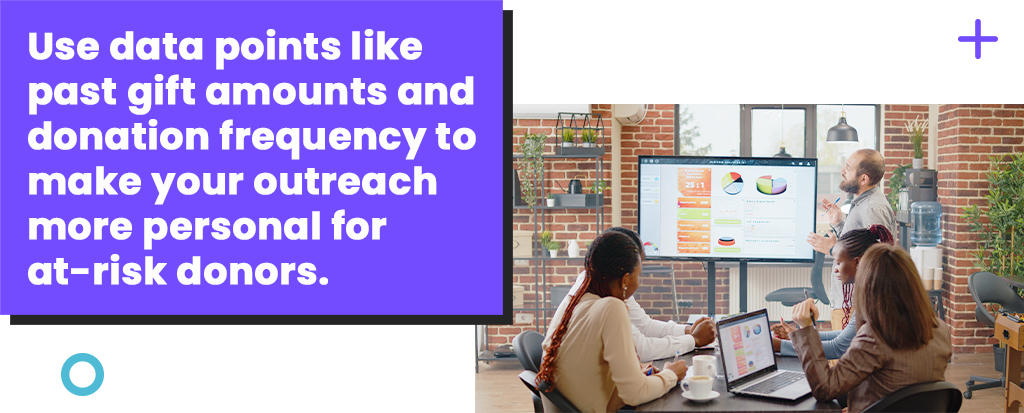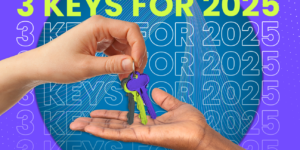As you know, being personal and relevant is a critical component of any fundraising strategy. So, it’s important to consider the current state of your relationship with any donor before you ask for support. After all, your at-risk donors will need to hear a very different message than your most engaged supporters.
You can consider anyone who has given to your organization in the past but not within the last year as at risk of lapsing. But these individuals are not a lost cause! They just need to hear a different message.
Several factors can explain a lapsed gift. But not all of them are within your control.
So, don’t assume an at-risk donor is no longer interested in helping your nonprofit reach its goals!
According to the latest data from the Fundraising Effectiveness Project, new donor retention is down 22.7 percent from last year. And repeat donor retention is down 2.9 percent. As fundraisers, we have our work cut out for us.
So, as you’re gearing up for your next appeal, create a segment for donors who supported your annual fund or another major initiative last year but have yet to give this year.
Then, use the following advice in your outreach to open a dialogue and encourage your at-risk donors to join in and help your organization achieve its mission once again.

Know who you’re speaking to.
Donor retention is not easy. But you will have a bigger impact on your mission if you can convince at-risk donors to give again now rather than attempt to recover them after they lapse.
According to the data referenced earlier, the average donor recapture rate is down 2 percent from last year.
So, you will need to be strategic with your messaging if you want to stop your at-risk donors from lapsing!
Pull any relevant data you have about your at-risk donors. Information about past gift amounts, donation frequency, and what programs they supported are particularly important. If possible, determine why they haven’t made their usual contribution.
All this information will help you be more personal and relevant when you reach out!
READ MORE: Applying data-driven ask strings in your appeals.

What have they heard?
What were the last few communications each at-risk donor received? And have they been opening and clicking your emails but stopping before making a gift? Or are your messages being marked as spam?
Donor fatigue is a real concern. Fundraisers need to vary their messages and reach out with different types of communications to retain donors long-term.
So, look for ways to add extra touches in your outreach strategy. Let’s say the last time a donor heard from you was when you invited them to your annual awards dinner. They didn’t attend, and that’s OK!
But what’s not OK is if they don’t hear from you for months before you hit them with an appeal.
It’s important to balance your messages. So, consider sending a newsletter about the event to follow up. Highlight award winners and other important moments from the night to keep your donors in the loop.
The worst thing an organization can do is make their donors feel like a source of income. The donor/organization relationship is supposed to be a partnership. One where you work together to achieve a shared goal. So, make sure your supporters know you care about more than their next gift.

Do you seem ungrateful?
When a new or repeat donor makes a gift, we know we need to thank them promptly. However, one of the reasons your donor retention rate may be suffering is because your thank you’s don’t do much more than say “thanks!”
When someone holds the door open for you, a simple “thanks” will suffice. But you need to do more when someone opens their wallet and helps you advance your mission!
Include pictures of the people you serve and invite at-risk donors to participate in volunteer opportunities to make a bigger impact.
Your supporters will not stick around if you’re not putting enough effort into your stewardship strategy. At-risk donors need to understand the difference their past support has made. And you need to let these supporters know your organization is counting on them so you can make a bigger impact together.
Versioning your next appeal.
But don’t do all this work just to send your at-risk donors the same appeal you send current donors!
Your data can help you determine the right ask for at-risk donors. Consider using an at-risk donor’s last gift as the high-end ask to make renewing their gift an easier decision.
And don’t forget to consider how to adapt your message itself.
Start by sharing a little about everything your organization has accomplished since the last time a donor gave. Then, let them know the impact they can make with another gift to your nonprofit. You can use variable data to specify the date and dollar amount of past contributions for each donor to be even more personal.
But remember, you’re not trying to make at-risk donors feel guilty for not giving to your organization. You want to nurture and rekindle the relationship you have with them.
Think about your outreach to at-risk donors as if you were reaching out to an old friend. It’s about touching base and seeing if you can pick up where you left off, maybe over a cup of coffee. So, you shouldn’t sound desperate like someone begging an ex-partner to give them another chance!
Click here to talk specifics about how to engage your at-risk donors!









